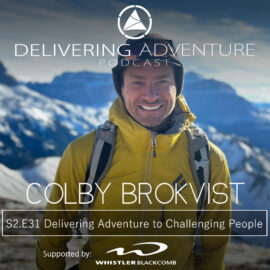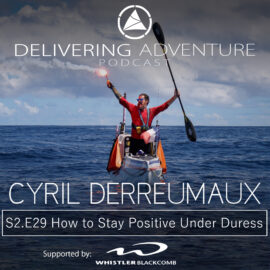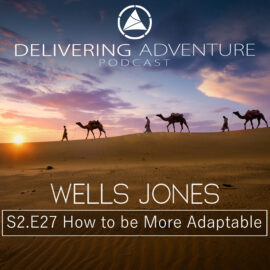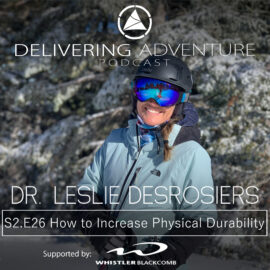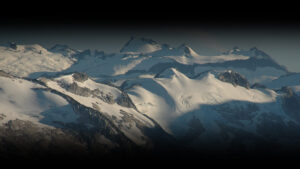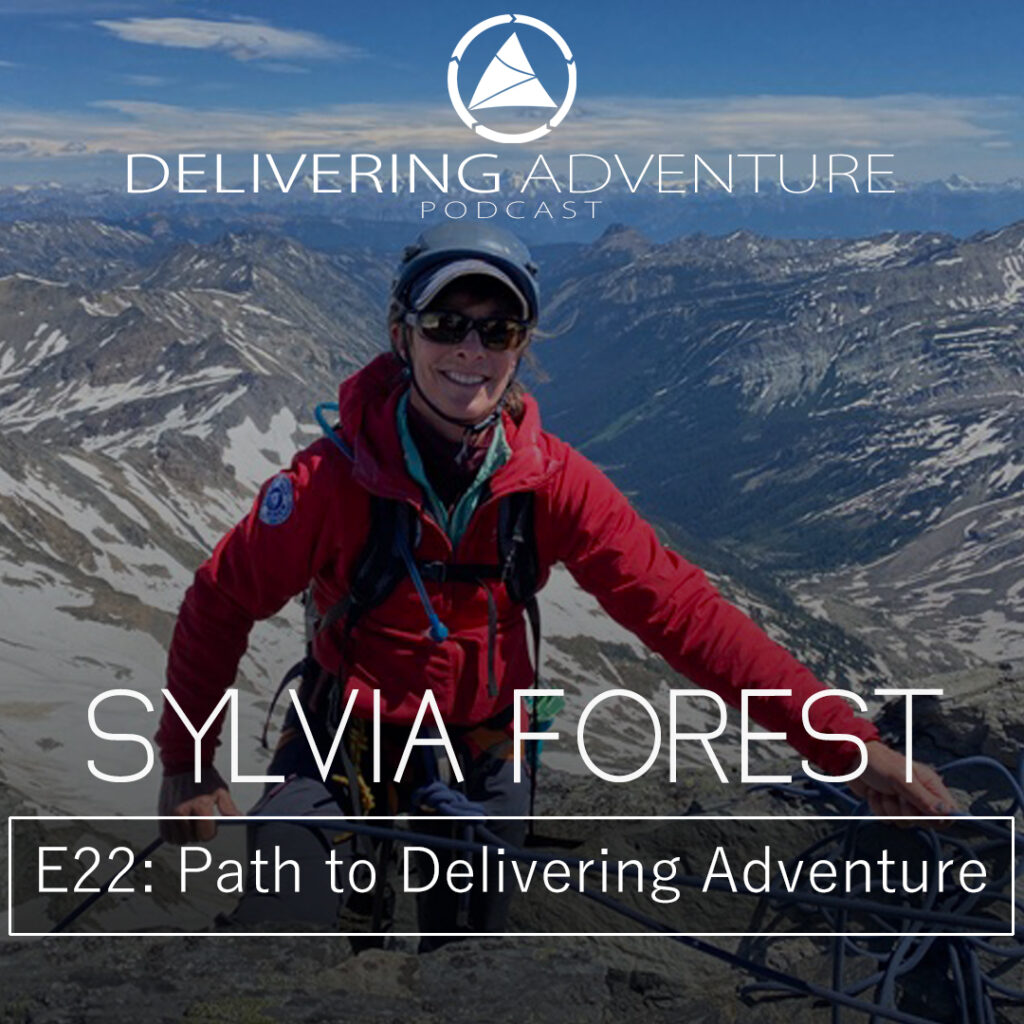
Path to Delivering Adventure with Sylvia Forest
Sylvia Forest joins us to explore her path into the adventure delivery industry from being a park warden to becoming an ACMG / IFMGA Mountain Guide. Sylvia shares some of her challenges, successes, and a few key pieces of wisdom that we can all learn from.
In addition to guiding, Sylvia is a guide trainer and examiner and is also the current President of the Association of Canadian Mountain Guides.
Key Takeaways
How to help yourself and others on the path to adventure includes:
Knowing yourself: Figuring out what you want to do in life starts with knowing yourself and what you are capable of.
Knowing your audience: it is hard to get the best out of people if you don’t know what they can do, their expectations, how they react under duress, and who they are as people.
The first one is to learn to embrace failure: Failures help to make us more resilient.
Avoid punishing people for mistakes: While some people thrive on constant critiquing, most people don’t perform at their best when they are forced to dwell on their missteps.
Help others to find value in failure: Some strategies that we can use include: highlighting lessons learned, successful strategies that were used, processes and what could be done to get a better result in the future, are all ways of turning a negative experience into a valuable one. Another important component is to draw attention to what went right.
Guest Links & Resources
Association of Canadian Mountain Guides: Website
Guardians of the Peaks by Kathy Calvert and Dave Portman: Available Here
Follow or Subscribe
Don’t forget to follow the show!
Share & Social Links
https://linktr.ee/deliveringadventure
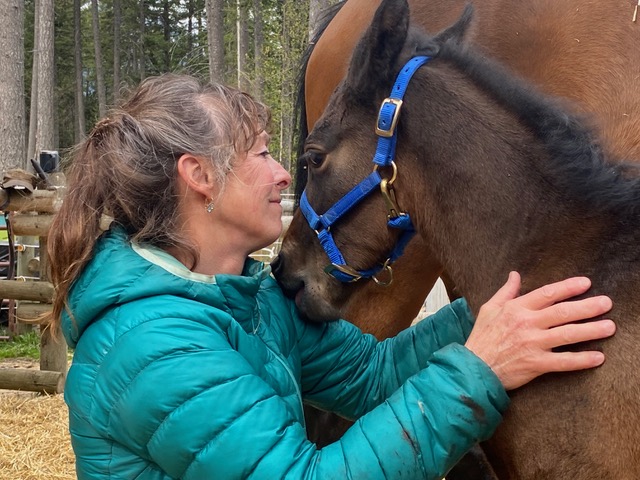
Episode Transcript
[00:00:00] Sylvia Forest: That was a very difficult rescue. There was crevasses on all sides of us. You couldn’t move more than a few feet in any direction without encountering a crevasse. And uh, we ended up, because this was late at night, we ended up all camping, right, uh, beside the crevasse that this woman had fallen into. And I recall driving past the Athabasca Glacier about a day later to only to see an ice fall come down and annihilated the place that we have been counting for 12 hours.
[00:00:30] Chris Kaipio: Welcome to Delivering Adventure. This is the podcast that explores what it really takes to share adventure like a pro with your friends, your family, and as a profession. My name is Chris Kaipio, and I’m coming to you from Whistler, British Columbia.
[00:00:48] Jordy Shepherd: And I’m Jordy Shepherd.
Recording from Canmore, Alberta. After a lifetime of working extensively in different parts of the adventure guiding industry, Chris and I have teamed up to launch this podcast. In each episode, you’ll hear top adventure guides, managers, marketers, and athletes share their best stories, advice, and trade secrets.
The goal of this podcast is to share how you can take yourself and others farther from the mountains to the office and.
[00:01:17] Chris Kaipio: In this episode, we are joined by Sylvia Forrest. Sylvia is going to be sharing with us a little bit about her path into the adventure delivery industry and some of the keys to what has allowed her to succeed.
This is the first of two episodes we have with Sylvia. In this second episode, we drill down into some of the key strategies that she uses to help others to.
[00:01:42] Jordy Shepherd: Sylvia is an internationally certified mountain guide who is based in Golden British Columbia. In addition to guiding, she works as a guide trainer and examiner for the Association of Canadian Mountain Guides Training and Assessment Program.
Sylvia is currently serving as president of the ACMG, and she’s also worked as a park warden and visitor safety specialist, and Canada’s Mountain national. So, Chris, uh, you and I work, uh, both with Sylvia on the ACMG Board of Directors. We’ve done that for a number of years. She’s a pleasure to work with, and I’ve also worked with her in Parks Canada, uh, doing visitor safety work and other park warden work.
[00:02:19] Chris Kaipio: So, okay. Let’s bring Sylvia into the DA studio.
[00:02:25] Jordy Shepherd: Welcome to the show, Sylvia. We’re excited to have you here. Can you tell us a little bit about yourself?
[00:02:34] Sylvia Forest: Sure. Um, and thanks for having me. This is, uh, an amazing opportunity. Um, what can I say about myself? Um, I am a mountain guide. I, uh, started my gutting, uh, career back in the nineties and in the very early nineties I joined the Warden Service.
I was at Park Warden for 23. Uh, in that time I worked as a mountain safety specialist. I also teach avalanche, uh, industry courses for the Canadian Avalanche Association. I also, um, have horses, quite a number of them, and do back country horse trips with them. Um, I’m a grandma and, uh, that’s about it.
[00:03:24] Jordy Shepherd: Awesome. Where, where are you calling in?
[00:03:24] Sylvia Forest: I am currently living just outside of golden BC on a small little hobby farm.
[00:03:32] Jordy Shepherd: Great. You have quite a family history with mountaineering. Can you elaborate on that for our listeners? Um, I think it’s important for y them to understand where you come from in terms of, of this delivering adventure and mountaineering history.
[00:03:47] Sylvia Forest: Sure. Um, I grew up in a household of climbers and mountaineers. Uh, the short story is, uh, my dad was an engineer, hailing from Saskatchewan, moved to Calgary, brought his kids to Calgary, and at that time I would’ve been about a year old and my older siblings who are quite a bit older were in high school.
The Alpine Club was looking. Uh, get younger members of the Alpine Club to join. So, they came home asking, uh, for permission to go to the mountains and asked if, uh, my dad or somebody could drive them there. So, he did. And on sitting on the side of the road for a day being bored, he finally approached the Alpine Clement and said, Hey, can I.
So from then on in, he started climbing first with, uh, my brother and sister who are twins and eventually developed his own group of friends. And you have to understand that he was 43 years of age when, when he started climbing and he took to it so much. It was a passion. Like I have rarely seen. He was in the mountains every weekend and when I was old enough, starting from the age of about eight, uh, he took me, me with.
When it was reasonable, of course, uh, my dad did go on to become the first person to climb all of the 11,000 foot peaks in the Canadian Rockies, but also in the Columbia Mountains, which, uh, includes the, the Selkirks and the PURLs. Uh, he’s also, uh, the oldest man to climb Mount Logan when he. 69 years old, or pardon me, 71 years old and he climbed, uh, in the Himalayas when he was 69 years old.
So that is the, uh, family background that I come from. Uh, of note, uh, my other siblings have stayed quite active and my sister in particular, uh, became a park warden and was in fact one of three women who were the very first park wardens hired in. . Um, the other two only lasted a couple of months and my sister lasted for 25 years, so she was, uh, quite a trailblazer.
So really we have quite a, a bit of a trailblazing family.
[00:06:15] Jordy Shepherd: Yeah. I’m your sister Kathy, uh, is also an author, uh, writing about mountain history and, uh, her and her husband, Dale Portman, who is a national park warden, dog handler, also wrote a book, uh, about the mountain rescue service in.
[00:06:31] Sylvia Forest: No, that’s right. When my sister retired from Parks, her second career became, uh, uh, as an author and writer and, uh, she’s written several books, a number of biographies, and as you said, the, uh, um, history of mountain rescue called Guardians of the Peak.
[00:06:49] Jordy Shepherd: So definitely check out, uh, Kathy Calvert and Dale Portman’s writings. Yeah, they’re awesome. Very fact-based, very well researched and, uh, interesting content. How do you define adventure? Sylvia?
[00:07:09] Sylvia Forest: You know, that’s a really good question. I had to think about that. Uh, because adventure is something that I think all of us like to do on a very regular basis. Adventure looks, uh, different to everyone. Uh, for me, adventure usually involves the mountains or the wilderness or, uh, something unusual. It could even be traveling in a place.
Uh, but for me. It’s something that has an element of being remarkable, of being unique, of potentially having an element of, of risk that keeps your adrenaline going a little bit. Uh, it doesn’t have to, but that’s often a little bit of a part of it for me. Um, and really what I think of is in life as well as in the mountains, we can’t always control things.
We can’t control everything. So being in an uncontrolled environment, doing something that you love to do and maybe challenging yourself a little bit. That is what adventure is to me.
[00:08:13] Jordy Shepherd: Nice. That’s, uh, yeah, nice recap on that. And what does delivering adventure mean to you in, in the things that you’ve done?
Um, so you’ve adventured yourself, but in terms of delivering it to others,
[00:08:28] Sylvia Forest: You know, in terms of delivering it to others, and I think I’m going to speak about this a little bit, uh, in, in, in the next little while, um, delivering adventure to others is providing. Same opportunities to have that, um, experience of being somewhere, you know, in this case, mostly in the mountains. It could be, uh, uh, in canoes.
It could be, you know, in different locations. But for me it’s mostly in the mountains. Um, Where the people that I take out can have that sense of doing something they’ve never done before. Uh, going a place they’ve never seen before, having experiences that they’ve never had before, but in a safe environment or as at least as safe as is reasonably possible while still maintaining that element of adventure.
[00:09:22] Jordy Shepherd: Excellent. You’ve been a park warden, a guide, A guide trainer. Tell us a bit about your path to, to get there. I probably wasn’t always a straight path.
[00:09:38] Sylvia Forest: Oh, I had a very circuitous path. I mean, some people know exactly what they want to do when they grow up, and I, to be honest, I’m still working on that. I still don’t know what career number three, four, or five is going to be.
Um, Answer, I, well, it’s not all that short, but, um, you know, I grew up, uh, in an environment where education was paramount and everybody in my family has a fairly high level of education. As a matter of fact, I think the only per, I’m the only one in my family that doesn’t have a master’s or a doctorate degree.
Um, but growing up I was not an academic. I struggled a lot in, in academia. Most of the time I was staring out the window. Of whatever classroom I was in. Uh, that said, I thank, I thank uh, my family for really twisting my arm to go through university. Uh, During, uh, university I was out climbing and mountaineering as much as I could be.
I was introduced, uh, in the, my early twenties to something called the Cadet Camp, the national Army Cadet Camp, um, in which I was brought on as a summer instructor, and I got to work alongside mountain Guides and I thought, oh my God, this is what I want to. , this is what I would really like to do, is be a mountain guide.
I looked at what they were doing and that I thought this suits me perfectly. I also got a job, uh, paying my way through university teaching, uh, climbing at a climbing gym, but university had to take priority. It took me a long time to get through Univers University and thank goodness I did because it opened a mi a million doors for me that if I didn’t have that university education, uh, I wouldn’t have merely the opportunities that I have.
Uh, going forward, I took another left turn away from guiding in terms of joining the Warden Service, and I have to give my sister, Kathy Calvert full credit for this. I watched what she was doing as a park warden, which by the way, at that time, included a whole bunch of things like mountain rescue and training in the mountains, and I saw a path.
So I diverted from becoming a guide through the ACMG for a little while until I got my feet underneath me with parks, and I had an amazing early career with parks doing a variety of things. But eventually I realized that to really do what I wanted to do, which is mountain rescue and visitor safety, I had to become a mountain guide.
So it took a while, a bit of a circuitous route, but eventually I became a mountain guide and, uh, I was able to use that in my visitor safety career as well as, um, guiding, uh, for.
[00:12:25] Jordy Shepherd: Yeah, there’s a very rich history in the National Parks Warden Service and yeah, we could probably go on and on about all the other variety of stuff, that you’ve done, um, within that, because yeah, you worked as a warden.
I did too. And uh, it was during a time when we were jack of all trades and potentially masters of none. But we got the job done and actually we were kind of masters of it all too, which was, uh, pretty cool. You know, he. Pick up and you know, the call comes in and off you go. There’s a wildlife call or there’s a law enforcement call, or, um, you’re doing some wildlife studies or vegetation studies on the next day and, and then, uh, oh, off to do a rescue because somebody’s fallen in a CVAs and Yeah.
Yeah. Very, very varied, um, career, which is great and, and huge public service too. Um, that, that you’ve offered.
[00:13:16] Sylvia Forest: Mm-hmm, you know, those, those early days in the warden service were magical. Um, you know, most of us have formative years that are really special, and that was my formal formative time. It was amazing.
And as you say, on a given day, uh, you might be going to a rescue, you might be putting out a fire, you might be lighting a fire in a prescribed burn. You might be dealing with, uh, wildlife issues, bears and uh, elk in the campgrounds. and for myself, I also spent several years, uh, patrolling the back country on horseback where I would go out for, uh, 17, 18 days with a saddle horse, two pack horses, and maybe not see anyone for 18 days doing your workout there.
And it was, it was magical.
[00:14:03] Jordy Shepherd: How about your, uh, you’ve done a lot of, uh, adventuring in a smaller way, you know, kind of day trips and that sort of thing. Uh, how about some of your bigger adventures? Do you have any stories from that?
[00:14:13] Sylvia Forest: You know, uh, it’s, it’s. As you can imagine, uh, at my point in life, I’ve done quite a number of things and it’s kind of hard to peg down anything specific.
I mean, uh, I’ve got to tell you, one of my biggest adventures was deciding to travel through North Africa when I was 18 for several months. I, I went over for three months and stayed for 10. Um, that was a heck of an adventure. But I think what you’re really after is more of my mountaineering exploits and, uh, you know, I’ve had quite a number, I guess.
Uh, A couple that come to mind is when I was quite young. I’d say I was about 19. I went to climb Mount Cook in New Zealand, uh, for a day trip and talk about error upon error upon error. It’s amazing that I’m alive. Uh, I was quite young, quite inexperienced, climbing with some older friends. and partway up.
Uh, on the first day we got severely weathered in, which is very common in New Zealand. Uh, the weather there is, is quite ferocious and comes in quite rapidly and very long story short, uh, that one day climbing adventure turned into five nights of trying to survive on a mountain at high elevation, and that’s a fairly detailed story, which I’m not sure how much I should go into, but, uh, uh, it, it has been written about.
And, uh, suffice to say, it’s amazing. I’m here. I shouldn’t be. That’s one of many. I I’ve had several I’ve, I’ve gone well past my nine lives. Um, I, I’ve had quite a number of other amazing mountaineering adventures. You know what, again, doing some of the big grand ski traverses at a young age, uh, always with women, um, which was pretty cool because women just didn’t stuff like do stuff like that without men at the.
I’m talking, uh, sort of mid eighties and, uh, of course I can’t not mention, uh, the climb that I climbing the East Ridge of Mount Logan with three other women in 1993, which was amazing. Oh, and also climbing Mount McKinley in 1983 when I was 23 years old with another woman.
[00:16:39] Jordy Shepherd: And, and on that theme, um, of, uh, of, you know, being ear, an early pioneer as a female in the mountaineering world, uh, where, where were you in your certification in terms of the, um, the lineup of female guides that were, became mountain guides?
[00:16:57] Sylvia Forest: Um, well, I am number five. Um, And I can talk about that later a little bit. But, uh, yeah, number five. So my predecessors, of course, Danny Harrison was, uh, the first, uh, woman to become a, a Canadian, a mountain guide under the Canadian ACMG certification process. Um, I believe Alison Andrews, Helen Sovdat, and Kristen Knechtel, and then myself.
And I finished in 2001 and now I, I’m not sure where we’re at. We just had a, a new, uh, female Mountain Guide certified this year, Morgan Bunston, and I forget what number we’re at, but we’re still not very high. I think we’re like 12 or 13.
[00:17:44] Chris Kaipio: That’s a, that’s amazing. Sylvia. I have a confession to make before I became a guide or even wanted to become a guide. I actually wanted to become a, a park warden, which a lot of people don’t, don’t know. And uh, I didn’t make it there, but I’ve always been fascinated, um, by that, um, that role. And, you know, you see the people working in the parks and, and I’m curious to know if you have any interesting stories about working in the national parks that you can share with.
[00:18:17] Sylvia Forest: You know, uh, boy, I have a lot. And the question is where exactly to start. Um, I think, uh, you know, I just want to preface by saying that, um, almost everything that we do, not just in guiding, but also within the national parks there, there’s a big element of team. Being a part of a team is huge. And in national parks, that was, that was, uh, really, really important.
So, whether it was, uh, dealing with wildlife in the campgrounds, whether it was dealing with a rescue, um, whether it was doing avalanche control, it was all teamwork. And even when I was working, um, in an is isolated environment, patrolling by myself in the back. , at least on the radio. There were other folks out there.
So, it still felt a bit like a team. So I think the team environment was really important for me. Um, I can relay, uh, one story of a mountain rescue that was, uh, you know, really quite something. And of note I had just passed. My apprentice ski exam, uh, I was on it with a fellow called Steve Blake, who, uh, some of your listener listeners may know he was, uh, a park warden and manage manager of in the public safety, uh, section as well.
But at that time, he and I were on our assistant or apprentice ski exam together. We’d just gotten out of Robson, Mount Robson area. I didn’t even have a shower. I just got home. Hadn’t even unpack. And we got a call that there was somebody in a CVAs on the Athabasca Glacier, and Steve and I were the point people.
So, he, I was living at Sun Wapta Warden Station at the time, uh, you might call it Mile 45, which is about, uh, 45 miles, uh, south of, uh, Jasper Town site and very close to the Columbia ice fields. So, Steve and I hopped into a helicopter and flew up to the site. Started, uh, got outta the helicopter, probed our way over to the edge of the crevasses, and found one person kind of walking around the edge of the crevasses and a rope going down into their crevasse.
This is a fairly long story, but I’m gonna shorten it. Uh, in essence, a party had been descending after five days of being on the Columbia ice fields in a white out. They were kind of a little annoyed with each other, and one by one decided to take the rope off because, uh, I don’t know if you’ve tried skiing downhill.
Roped up to other people, but it can be a very painful experience. If one person falls, the whole rope team falls, and of course you’re wearing great big, heavy overnight packs. So, this person unroped fell into AVAs about 60 vertical feet down, and her team didn’t know that she was missing until they regrouped at the bottom.
So, we got the call. Steve and I went in, and by the time things were done, we had a team of about 10 people, uh, trying to get this gal out of the crevasse. She was, uh, severely hypothermic. And your listeners can’t see me, but I can tell you that I’m not very big. I stand about five foot two. I weigh about 115 pounds.
Therefore, I’m always the one that gets lowered into the crevasse to deal with who’s ever in the bottom of the k. Um, that was a very difficult rescue. There was crevasses on all sides of us. You couldn’t move more than a few feet in any direction without encountering a crevasse. And, uh, we ended up, because this was late at night, we ended up all camping.
Right. Beside the crevasse that this woman had fallen into. I also should add that all of this is directly underneath the Mount Snow Dome Ice Fall, which is one of the most hazardous places you could possibly park yourself for a couple of minutes, let alone for overnight. Um, I’m happy to say that this is the, uh, rescue is successful.
We got the gal out and I recall driving past the Athabasca Glacier about a day later to only to see an ice fall come down and annihilate. A place that we had been camping for 12 hours. That’s one little story. I have many.
[00:22:44] Chris Kaipio: How did, how did that make you feel? Um, like when you, when you drove by and when you drove by and, and saw that, you know, saw that area get, that had been obliterated.
How did that make you feel?
[00:22:57] Sylvia Forest: Well, it made me feel very lucky, that it hadn’t happened. And you know, that’s part of traveling in the mountains. There are things that we can control and there’s things that we can’t control. Normally, a situation like that, you control that situation by avoidance. You recognize the hazard and you say, okay, I’m either going to avoid it or I’m going to minimize my exposure by going very quickly underneath it.
And in that situation, we couldn’t, um, you know, and I know Jordy could speak, uh, at quite some length about, as, as Kenai about, uh, at what point you put rescuers in a risky situation to save a life. And when you don’t, that’s a, that’s a difficult judgment call. So I can say that I felt, uh, grateful, relieved, um, and happy that nobody got.
[00:23:53] Chris Kaipio: Have you had any interesting bear or other animal encounters? That’s a, that’s a question that I always get asked. And in your role working in the parks and as a guide and, and the things that you do, I’m, I’m sure that you must have some great, uh, stories to share.
[00:24:09] Sylvia Forest: Uh. So, um, okay. I can relay a couple, I suppose.
You know, to be honest, uh, having spent my entire life in the back country, all of, most of the bear encounters I have had have been magical. And when I say magical, I’m referring to, for example, the time I was able to watch a grizzly bear in a high alpine pass digging for marmots. And I watched that bear at very close range for about an hour.
And that bear just kind of like a dog, dug in one hole, looked over to the next hole, dug in the next hole, went back to the first hole, completely immersed in the occupation of finding a marmot, which he never did. And after an hour, he suddenly looked up, looked directly at me, and then bolted up a near vertical snowball with a corns on it.
So those are the types of experiences I’ve had, uh, a lot, uh, in that they are amazing, magical and, uh, um, I didn’t feel frightened. Um, I have had a bar encounter. Uh, on horseback that was much more terrifying, in which I was, uh, trying to get from A to B And, uh, behind me, I had just been traveling for about 30 kilometers.
I had the horses on about a 30-degree, 35-degree Celsius Day with limited water. They were tired. I was tired, and the only way to get out, which there was only a few kilometers, was through this narrow. Part of the trail and we encountered a grizzly bear and that grizzly bear charged and it sounded like a lion.
And, uh, I was with, uh, my husband at the time actually, and that bear was so close to my husband’s horse as he was, he, as he was galloping away, that he could almost feel the claw of that bear on the rump of the. And so we stayed put knowing that we had, you know, like in the mountains, one lesson I’ve learned is you always need options.
You should never be in a place where you have no options. In this case, we had no options. Turning back and traveling 30 kilometers with no water for the horses was not a viable option, and really our only way out was to get to the trailhead. So we ended up sitting there for about an. Listening to that bear Howl.
And it turned out we didn’t realize that at the time, but after a while I could say, what? What is that other noise? And it was the balling of cubs. So, we had just intruded in a cell with her cubs and you know, after an hour she just left and we made our way out. But that was pretty terrifying.
[00:27:13] Chris Kaipio: Wow, that’s, that’s amazing.
I was at Consolation Lake once, uh, with a group near, um, near Moraine Lake and uh, there was a group of about 30 people at the end of the trail, and there’s a creek, and on the other side of the creek was a forest. And I kept hearing this, these sort of growling sounds. And nobody seemed to pay any attention to what they were, which was, which was interesting.
And, and I thought they were a bit strange and, and, uh, it went on for a long time. And then after probably. 15 or 20 minutes, three Grizzlies came out and there was two, um, cubs. Yeah. It was pretty amazing. And it, and it is amazing how noisy they are. Like, people do ask me, you know, if Bears growl and, and, and make sounds and things like that.
And, you know, based on your story and, and my story, yes. They, they, they do. And they can be pretty loud, you know, in that particular situation.
[00:28:10] Sylvia Forest: Uh, my husband, uh, who is spends, uh, as much time outside as I do, if not more, uh, knows Bears intimately. And he was quite convinced it was a bore with a kill. And just because it was such a big, massive bear, he got a pretty good b d I look at it and, um, it, it was quite interesting to find out that it was, you know, the balling of the cubs was what clued us.
[00:28:44] Chris Kaipio: Now I’ve heard a little bit about your story on how you became a guide and, and that sort of thing. And for people that haven’t gone through that process, it is quite demanding. Um, Sylvia, you were actually my examiner for my hiking guide, um, course. And I can tell you I put a lot of, uh, effort into that and to get to where you are required significantly, uh, more.
What kinds of obstacles did you have to overcome? You know, you were one of the first women, um, to become, uh, you know, a full, fully certified mountain guide. You’ve also noted that, you know, you are a little bit smaller and a lot of people do sort of equate unfairly, you know, a person’s size and to. being able to, to, you know, handle physical challenges and, and things like that.
And that’s something that you actually had noted, um, once in a, in a conversation we had. So what kinds of obstacles did you face and how did you overcome them?
[00:29:43] Sylvia Forest: You know, um, that, that’s a really good question. I sometimes have difficulty answering that question, but, but here’s, I’ll give it a shot. Um, I would like, I would have to say that I would, my early courses.
Uh, I didn’t feel like I had a lot of obstacles, and the reason is I started my certification process when I was a little bit older, um, in my mid thirties. as opposed to in my twenties. And, and I like to think that because I had some life experience, um, I was well set up to start and I had already done an extensive amount of climbing and mountaineering.
So, uh, a lot of the technical skills, a lot of the hard skills, a lot of the decision-making skills I had. And I think, uh, entering the guides exams with a lot of. Um, it’s helpful. Um, sometimes I see in recent years folks trying to get into the guiding program and they’re learning as they’re going, and I think they’re finding it a little bit more stressful.
So I’d say that, uh, my early years, my, you know, my apprentice level exams and even my full ski exam, I wouldn’t say I floated through them, but I enjoyed them and, if you’re enjoying it, it means you’re probably not all that stressed out, and it probably means that you’re fairly well prepared for them. Um, but to your question, when I look back on it, uh, yeah, I was definitely thrown a few, uh uh, um, uh, Things that, uh, maybe not everybody would be based on my size.
So, for example, I remember on one exam it was my apprentice Alpine. I was climbing in the bugaboos on pigeon spire, which is, uh, not a difficult climb that it’s quite exposed. , we had about four or six inches of snow on the route, making it very slippery. And my task was to short rope. And I don’t know if I need to define short roping in this podcast, but, um, to, to, uh, uh, guide people, uh, through mixed terrain.
So not necessarily putting in anchors, but uh, using the rope, going around, uh, terrain to keep people safe. I had two people on my, both of them were around six four and in the 200 pound range, and physics tells you that’s a very challenging situation. and, uh, that was, uh, I was given that kind of a ratio quite deliberately and quite frequently.
As a matter of fact, my main, uh, partner through most of my guiding courses, uh, was a fellow around six foot four and 200 pounds. Um, and I think that was done very intentionally to see if I could actually manage somebody of that size versus somebody closer to my own size. Um, on another occasion I chose my partner who was closer to my size and, uh, during a CVAs rescue exam, and one of the examiners actually came into the bottom of the CVAs and jumped really hard on the rope to make sure that it was a little bit more realistic.
So, I guess there were a few of those kinds of things. Um, But something that, uh, if I can continue, I think the real challenge, um, is, well, there’s the fear of failure and then there’s failure. So I didn’t pass all my exams without failure. I did fail my Alpine exam more than once. And I think the, the most difficult part was facing.
Failure and accepting it and learning from it, and having the strength of will to try again. I think for me, those were the bigger obstacles and accepting failure and living with it and learning from it. It was tough, but it really helped me later in life when I had other bits of failure here and there to manage.
[00:34:16] Jordy Shepherd: Thanks for this, Sylvia. We’re going to pause here for now so that we can recap some of the excellent points that Sylvia’s made so far. We’ll pick up the rest of Sylvia’s conversation in the next episode. Chris, when it comes to Sylvia’s path into the adventure industry and some of the things that has allowed her to succeed, what were some of the key takeaways from what she had to say, or some things that might have jumped out at you as you listen?
[00:34:39] Chris Kaipio: Well, throughout the production of this podcast, so far we’ve heard a number of different paths that people have taken to get into the adventure industry. One commonality though, is having parents or friends who have acted as role models, coaches and guides. Jordi. I know that both you and I have benefited from parents who have filled this.
That in itself isn’t enough, though. Like any career, figuring out what you want to do in life starts with knowing yourself and what you are capable of. This is a takeaway for me as I have watched, listened, being mentored by, and have worked with Sylvia, the person you start off as. Isn’t going to be the final version.
Evolving into what you can be and knowing what you are going to like and be good at takes time. It also takes the opportunity to do different things. A number of years ago, I listened to the presentation by a former c e o of the Mountain Equipment co-op here in Canada. His advice was to go out and do as many different things as.
Listening to Sylvia tell her story, I can see how her many different experiences and roles have helped her to evolve not only her adventure career, but her life. So a key takeaway for me is that when it comes to delivering adventure, you have to know yourself. If we apply this to delivering adventure to others, which is what we are going to be doing in our next episode, one takeaway I want to highlight is knowing your.
Speaking from experience, I can tell you that you can’t really get the best out of people until you know them. There are a number of layers to this, including knowing what they can do, understanding expectations, how they react under stress, their background, and their triggers. However, there’s another component, and that is knowing just who a person is.
This is something that can be hard to find out unless we adopt a scout mental. Scout mentality is one where we really go looking for the facts with an open mind and leading with our curiosity in this case. I’ve known Sylvia for a few years now, and I’ve worked with her in a number of environments, but I have to confess that I didn’t know a lot of the things about her background that she shared in this interview so far.
The reason for this isn’t because I wasn’t interested. In fact, I’ve asked her a lot of questions when I have seen. The reason is that most people may not be that forthcoming. They might be shy, they might be private, or they may not think that those amazing details about themselves is of interest to anyone.
Finding out the extent of people’s expectations, abilities, experiences, and accomplishments can require real effort on our part, but in the end, that work pays. The reason that I want to highlight this is that what I have noticed is that most people don’t adopt a scout mentality. They don’t ask questions, and as a result, they make it harder for themselves to really get to know the people around them, which in turn makes it harder to get the best out of them.
[00:37:57] Jordy Shepherd: Well, Chris, thanks for that. I totally agree. Really getting to know yourself and people can help us to structure the right experience, expose people to the right amount of challenge, and to know when we might be pushing them too hard, or in some cases, maybe not hard enough. I have three takeaways to add, and they all relate to failure.
These things apply to us and to the people that we might be leading. So the first one is we need to learn to embrace failure. Failure can come in many different forms, including mistakes, missteps, misjudgments, miscalculations, challenges, malfunctions, near misses, and even injuries and accidents. While some of these things are obviously pretty bad and our situations we want to avoid, even the biggest failure provides us an opportunity to learn and grow while we’re.
Working to make the best decisions possible and manage situations so that people don’t get hurt or worse mistakes do happen. So learning from our mistakes is what separates a pro from an amateur. Embracing failure can help us to develop experience, skills, and resiliency. The second point I wanted to, uh, discuss about Sylvia’s first interview here was avoid punishing people for mistakes.
If we want to get the best outta people, they need to see themselves succeeding. While some people thrive on constantly critiquing, most people don’t perform at their best when they’re forced to dwell on their missteps. Of course, there are times when people do need to be aware, uh, and made aware of what didn’t go well and what, why that happened.
This is especially true in high-risk situations. One strategy. The way we can use is to frame feedback as advice on how to be better in the future instead of focusing on what someone did wrong. This is something that Sarah Hicken touched on in episode nine. How we frame feedback can mean the difference between someone improving or imploding.
The third point that I want to discuss is helping others define value and failure. Adding to this point is the importance of helping people to see failures and challenges as valuable. While we touched on the importance of embracing negative outcomes as opportunities to grow, we need to be aware of the importance of also encouraging others to do that as well.
This can often mean the difference between someone achieving an adventure or remembering the experience as a misadventure. Some strategies that we can use include highlighting lessons. Successful strategies that were used when there was success processes that could be done to get a better result in the future are all ways of turning a negative experience into a valuable one.
Another important component is to draw attention to what went right. Now, let’s turn it over to you. What were your takeaways? As always, we welcome your feedback, suggestions, and questions. You can find all of our contact and social media information at our website delivering adventure.com, as well as in the show.
Also, if you’d like to show, please take a moment to share it with your social network. This includes your friends and any social media groups that you belong to that might benefit from the show. In the next episode, Sylvia Forest continues to share her thoughts on coaching people giving feedback, and talks about her role with the Association of Canadian Mountain Guides.
Thanks very much for listening.


